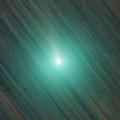
|
Now it is 8.0 mag (Sept. 29, Virgilio Gonano). It will fade out rapidly after this. In the Northern Hemisphere, it stays observable in good condition. In the Southern Hemisphere, it will be getting higher gradually.
Date(TT) R.A. (2000) Decl. Delta r Elong. m1 Best Time(A, h)
Oct. 7 7 3.66 25 56.3 0.393 1.067 88 7.7 4:35 (289, 69)
Oct. 14 7 34.68 19 47.5 0.410 1.064 87 7.5 4:40 (303, 66)
|
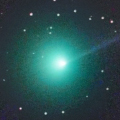
|
Now it is 9.4 mag (Sept. 28, Marek Biely). It will fade out rapidly after this. It will be fainter than 18 mag in January. In the Northern Hemisphere, it will be unobservable soon. In the Southern Hemisphere, it will never be observable after this.
Date(TT) R.A. (2000) Decl. Delta r Elong. m1 Best Time(A, h)
Oct. 7 11 6.06 11 54.0 0.978 0.523 30 8.3 4:35 (264, 13)
Oct. 14 11 58.02 3 23.2 1.086 0.408 22 7.7 4:40 (269, 4)
|
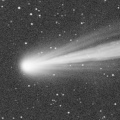
|
It approached to Sun down to 0.23 a.u. and brightened up to 2.5 mag in mid September (Sept. 18, Juan Jose Gonzalez). Fading rapidly. It will be fainter than 18 mag in January. Now it is not observable. It will appear soon in the Southern Hemisphere, or in November in the Northern Hemisphere.
Date(TT) R.A. (2000) Decl. Delta r Elong. m1 Best Time(A, h)
Oct. 7 12 56.61 -19 10.2 1.563 0.641 14 8.0 19:00 ( 82,-24)
Oct. 14 12 56.12 -23 23.6 1.716 0.807 16 9.2 4:40 (284,-23)
|

|
Now it is 9.9 mag (Sept. 24, Juan Jose Gonzalez). Fading gradually. In the Northern Hemisphere, it will be unobservable in January. In the Southern Hemisphere, it stays observable in good condition.
Date(TT) R.A. (2000) Decl. Delta r Elong. m1 Best Time(A, h)
Oct. 7 1 17.69 -34 49.3 1.972 2.807 139 10.0 0:19 ( 0, 20)
Oct. 14 0 57.06 -37 46.1 2.067 2.854 134 10.1 23:24 ( 0, 17)
|
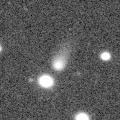
|
It is expected to brighten up to 7 mag in early 2024. Now it is 12.3 mag (Sept. 16, Jose G. S. Aguiar). It will brighten rapidly after this. In the Northern Hemisphere, it is not observable now, but it will appear in November. It locates somewhat low in the Southern Hemisphere. But it will become high in winter. The brightness evolution slowed down since May.
Date(TT) R.A. (2000) Decl. Delta r Elong. m1 Best Time(A, h)
Oct. 7 10 17.41 -33 21.5 2.860 2.266 44 10.8 4:35 (308, -5)
Oct. 14 10 35.54 -34 28.5 2.781 2.193 45 10.6 4:40 (311, -3)
|

|
It brightened very rapidly. It will approach to Earth down to 0.2 a.u. in November, and it is expected to brighten up to 7.5 mag. Now it is 11.5 mag (Oct. 2, Ken-ichi Kadota). It will turn to fade out rapidly after brightening. In the Northern Hemisphere, it will be unobservable in January. But it will be observable again in October. In the Southern Hemisphere, it is not observable now, but it will appear in November.
Date(TT) R.A. (2000) Decl. Delta r Elong. m1 Best Time(A, h)
Oct. 7 12 8.01 45 46.0 1.205 0.980 51 11.3 4:35 (227, 19)
Oct. 14 12 20.03 46 53.1 0.994 0.936 56 10.7 4:40 (228, 23)
|

|
It brightened up to 7.8 mag in late July (July 20, Thomas Lehmann). Now it is 11.7 mag (Sept. 15, Jose G. S. Aguiar). Fading gradually. It will be unobservable soon. But it will be observable again in November in the Northern Hemisphere, or in December in the Southern Hemisphere.
Date(TT) R.A. (2000) Decl. Delta r Elong. m1 Best Time(A, h)
Oct. 7 14 54.56 -12 50.2 2.520 1.755 32 12.0 19:00 ( 72, 3)
Oct. 14 14 56.56 -12 14.1 2.655 1.807 25 12.2 18:51 ( 75, 0)
|

|
It brightened up to 8 mag from 2022 summer to 2023 spring. Now it is 11.6 mag (Sept. 24, Osamu Miyazaki). Fading slowly. It stays observable in good condition.
Date(TT) R.A. (2000) Decl. Delta r Elong. m1 Best Time(A, h)
Oct. 7 6 49.42 -8 17.4 3.727 3.842 88 12.1 4:35 (334, 43)
Oct. 14 6 47.57 -8 17.7 3.684 3.906 95 12.1 4:40 (346, 46)
|
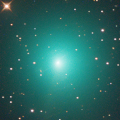
|
It brightened up to 8.4 mag in late July (July 22, Thomas Lehmann). Now it is 12.4 mag (Sept. 24, Ken-ichi Kadota). Fading rapidly. It will be fainter than 18 mag in December. It stays observable in good condition.
Date(TT) R.A. (2000) Decl. Delta r Elong. m1 Best Time(A, h)
Oct. 7 22 28.73 -22 15.6 0.966 1.824 136 12.7 21:26 ( 0, 33)
Oct. 14 22 34.61 -23 50.4 1.104 1.904 129 13.3 21:05 ( 0, 31)
|
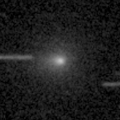
|
Now it is 12.7 mag (Oct. 1, Taras Prystavski). It will fade out rapidly after this. In the Northern Hemisphere, it will be getting higher gradually. It locates somewhat low in the Southern Hemisphere.
Date(TT) R.A. (2000) Decl. Delta r Elong. m1 Best Time(A, h)
Oct. 7 16 25.95 -5 52.3 1.294 1.076 54 12.9 19:00 ( 62, 25)
Oct. 14 16 55.81 -5 44.4 1.257 1.067 55 12.8 18:51 ( 60, 27)
|

|
Now it is 13.7 mag (July 14, Chris Wyatt). It stays 13 mag for a while. In the Northern Hemisphere, it will be unobservable soon. But it will be observable again in October. In the Southern Hemisphere, it will be getting higher gradually.
Date(TT) R.A. (2000) Decl. Delta r Elong. m1 Best Time(A, h)
Oct. 7 10 44.06 -22 17.0 4.792 4.009 34 13.1 4:35 (295, -3)
Oct. 14 10 45.25 -23 44.2 4.762 4.035 39 13.2 4:40 (301, 2)
|
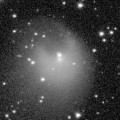
|
It returns for the first time in 70 years. It will brighten up to 4.5 mag in 2024 spring. It suddenly brightened in outburst by 5 mag up to 11.5 mag on July 20 (E. Tamas, Francois Kugel). It brightened again in another outburst up to 11.7 mag on Oct. 5 (Richard Miles). Now it is 11.4 mag (Oct. 5, Martin Masek). It will brighten rapidly after this. In the Northern Hemisphere, it stays observable in good condition. In the Southern Hemisphere, it is not observable now.
Date(TT) R.A. (2000) Decl. Delta r Elong. m1 Best Time(A, h)
Oct. 7 17 22.35 45 48.4 3.066 3.039 79 13.4 19:00 (122, 58)
Oct. 14 17 26.27 44 36.2 3.019 2.960 77 13.6 18:51 (119, 56)
|
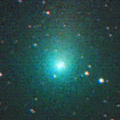
|
It brightened up to 9.5 mag from last winter to early spring (Jan. 30, Katsumi Yoshimoto). Now it is 12.2 mag (Sept. 24, Thomas Lehmann). It will fade out rapidly after this. It stays observable in good condition.
Date(TT) R.A. (2000) Decl. Delta r Elong. m1 Best Time(A, h)
Oct. 7 22 54.02 -0 8.5 2.378 3.288 150 13.6 21:51 ( 0, 55)
Oct. 14 22 47.14 -2 41.5 2.511 3.352 141 13.8 21:16 ( 0, 52)
|

|
It brightened up to 8.3 mag in 2021-2022 winter (Jan. 6, 2022, Toshiyuki Takahashi). Now it is 13.2 mag (July 14, Chris Wyatt). It stays 14 mag for a while. In the Northern Hemisphere, it is not observable now, but it will appear in November. In the Southern Hemisphere, it will be getting higher gradually.
Date(TT) R.A. (2000) Decl. Delta r Elong. m1 Best Time(A, h)
Oct. 7 10 52.48 -37 46.3 7.184 6.474 41 13.7 4:35 (307,-13)
Oct. 14 10 57.49 -38 40.2 7.207 6.519 43 13.8 4:40 (311,-10)
|

|
The ATLAS search program detected its cometary activity in April. It continues to be brightening even after the perihelion passage. Now it is 13.4 mag (Sept. 17, Ken-ichi Kadota). It will fade out rapidly after this. It will be fainter than 18 mag in January. In the Southern Hemisphere, it stays observable in good condition.
Date(TT) R.A. (2000) Decl. Delta r Elong. m1 Best Time(A, h)
Oct. 7 23 35.32 -26 23.7 2.271 3.134 143 13.8 22:32 ( 0, 29)
Oct. 14 23 33.01 -25 44.8 2.354 3.170 138 14.0 22:02 ( 0, 29)
|
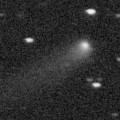
|
Now it is 13.9 mag (Sept. 17, Taras Prystavski). Fading gradually. In the Northern Hemisphere, it stays observable in good condition. In the Southern Hemisphere, it will be getting lower gradually after this, and it will be unobservable in January.
Date(TT) R.A. (2000) Decl. Delta r Elong. m1 Best Time(A, h)
Oct. 7 0 8.61 5 44.0 2.481 3.470 170 13.9 23:04 ( 0, 61)
Oct. 14 23 51.38 5 10.2 2.544 3.495 159 14.0 22:19 ( 0, 60)
|

|
Now it is 13.4 mag (Sept. 16, Chris Wyatt). Fading slowly. In the Northern Hemisphere, it is not observable now. In the Southern Hemisphere, it stays observable in good condition. It was expected to brighten up to 10 mag from spring to summer. However, it was fainter than originally expected.
Date(TT) R.A. (2000) Decl. Delta r Elong. m1 Best Time(A, h)
Oct. 7 11 53.93 -76 0.6 3.593 3.406 71 13.9 4:35 (343,-35)
Oct. 14 11 58.17 -76 44.7 3.652 3.435 69 14.0 4:40 (344,-33)
|

|
Now it is 14.7 mag (Sept. 18, Hidenori Nohara). In the Northern Hemisphere, it stays observable in good condition. It locates somewhat low in the Southern Hemisphere.
Date(TT) R.A. (2000) Decl. Delta r Elong. m1 Best Time(A, h)
Oct. 7 8 32.40 21 23.7 6.445 6.142 68 14.0 4:35 (277, 49)
Oct. 14 8 35.50 21 11.0 6.340 6.144 74 13.9 4:40 (283, 55)
|

|
It will turn to fade out rapidly after brightening. It will be fainter than 18 mag in January. In the Northern Hemisphere, it will be unobservable soon. But it will be observable again in November. In the Southern Hemisphere, it is not observable now, but it will appear in November.
Date(TT) R.A. (2000) Decl. Delta r Elong. m1 Best Time(A, h)
Oct. 7 11 8.64 1 49.1 1.126 0.491 25 15.2 4:35 (272, 7)
Oct. 14 12 15.16 -6 5.2 1.122 0.298 14 14.0 4:40 (274, -5)
|
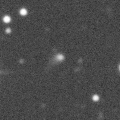
|
Now it is 14.5 mag (Oct. 2, Ken-ichi Kadota). Brightening slowly. It will be getting higher gradually. It is expected to brighten up to 12 mag from 2024 to 2025.
Date(TT) R.A. (2000) Decl. Delta r Elong. m1 Best Time(A, h)
Oct. 7 9 39.55 4 23.8 5.351 4.742 48 14.3 4:35 (284, 26)
Oct. 14 9 41.18 4 36.6 5.213 4.705 54 14.2 4:40 (289, 32)
|
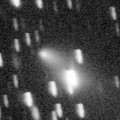
|
It brightened up to 13.6 mag in summer (July 16, Mitsunori Tsumura). Now it is 14.5 mag (Sept. 26, Thomas Lehmann). It will fade out rapidly after this. In the Northern Hemisphere, it stays observable in good condition. In the Southern Hemisphere, it will never be observable after this.
Date(TT) R.A. (2000) Decl. Delta r Elong. m1 Best Time(A, h)
Oct. 7 1 49.44 66 34.4 1.313 1.986 117 14.3 0:52 (180, 58)
Oct. 14 1 22.34 68 48.6 1.342 2.023 119 14.4 23:49 (180, 56)
|

|
It is expected to brighten up to 7 mag, and it will be observable in good condition in winter. Now it is 14.4 mag (Oct. 2, Ken-ichi Kadota). Brightening rapidly. In the Northern Hemisphere, it stays observable in good condition. It locates somewhat low in the Southern Hemisphere. But it will become high in winter.
Date(TT) R.A. (2000) Decl. Delta r Elong. m1 Best Time(A, h)
Oct. 7 6 22.06 21 48.6 1.074 1.566 98 15.5 4:35 (319, 73)
Oct. 14 6 44.49 21 56.9 0.992 1.522 99 14.6 4:40 (326, 75)
|
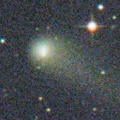
|
It brightened up to 11.1 mag in early 2022 (Mar. 31, 2022, F. Kugel, J.-G. Bosch, J. Nicolas). Now it is 14.0 mag (Sept. 22, S. Shurpakov). It stays 15 mag for a while. It locates somewhat low in the Northern Hemisphere. But it will become high in winter. In the Southern Hemisphere, it will be unobservable soon. But it will be observable again in February.
Date(TT) R.A. (2000) Decl. Delta r Elong. m1 Best Time(A, h)
Oct. 7 15 49.73 16 44.6 6.368 5.775 49 14.6 19:00 ( 89, 31)
Oct. 14 15 55.08 16 26.8 6.451 5.811 46 14.7 18:51 ( 91, 28)
|
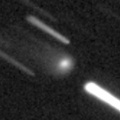
|
Now it is 14.9 mag (Sept. 18, Ken-ichi Kadota). Brightening slowly. It will be unobservable soon in the Southern Hemisphere, or in November in the Northern Hemisphere. But it will be observable again in December. It is expected to brighten up to 12.5 mag in 2024 spring. At the high light, it will be observable in excellent condition in the Southern Hemisphere, but it will be low in the Northern Hemisphere.
Date(TT) R.A. (2000) Decl. Delta r Elong. m1 Best Time(A, h)
Oct. 7 15 8.39 -1 57.6 3.911 3.146 35 14.7 19:00 ( 79, 12)
Oct. 14 15 9.55 -3 20.4 3.944 3.110 29 14.7 18:51 ( 80, 8)
|

|
It will brighten up to 14 mag from 2024 to 2025. Now it is 15.2 mag (July 22, ATLAS Chile). It stays 15 mag for a while. In the Northern Hemisphere, it is not observable now, but it will appear in November. In the Southern Hemisphere, it will be getting higher gradually.
Date(TT) R.A. (2000) Decl. Delta r Elong. m1 Best Time(A, h)
Oct. 7 11 1.58 -29 48.5 6.398 5.611 35 15.0 4:35 (299,-11)
Oct. 14 11 8.34 -30 20.8 6.351 5.587 37 15.0 4:40 (303, -6)
|

|
Now it is 14.3 mag (July 7, Thomas Lehmann). It stays 16 mag for a while. In the Northern Hemisphere, it is not observable now, but it will appear in January. It stays extremely low in the Southern Hemisphere. But it will become high in winter.
Date(TT) R.A. (2000) Decl. Delta r Elong. m1 Best Time(A, h)
Oct. 7 12 59.51 -49 24.2 3.385 2.759 44 15.4 19:00 ( 50,-35)
Oct. 14 13 18.55 -49 23.4 3.479 2.812 41 15.5 18:51 ( 50,-35)
|

|
It has not been observed yet in this apparition. It was expected to brighten rapidly up to 15 mag in summer. But actually, it is not detected, fainter than 19 mag (Aug. 12, Martin Masek). Fading slowly. It locates somewhat low in the Northern Hemisphere. In the Southern Hemisphere, it will be getting lower gradually after this, and it will be unobservable in January.
Date(TT) R.A. (2000) Decl. Delta r Elong. m1 Best Time(A, h)
Oct. 7 18 12.79 -25 5.8 1.918 1.999 79 15.4 19:00 ( 27, 25)
Oct. 14 18 27.00 -24 24.4 1.981 1.993 76 15.5 18:51 ( 28, 25)
|

|
It will approach to Sun down to 0.4 a.u. in late September in 2024, and it is expected to brighten up to 0 mag. Now it is 15.3 mag (Sept. 10, A. Ivanov et al.). Brightening gradually. In the Northern Hemisphere, it will be unobservable in November. But it will be observable again in November. In the Southern Hemisphere, it is not observable now, but it will appear in December. At the high light, in the Northern Hemisphere, it will be observable in good condition after the perihelion passage. In the Southern Hemisphere, it will be observable in the low sky before and after the perihelion passage.
Date(TT) R.A. (2000) Decl. Delta r Elong. m1 Best Time(A, h)
Oct. 7 14 16.96 -2 19.6 6.084 5.173 22 15.6 19:00 ( 86, 2)
Oct. 14 14 20.11 -2 49.4 6.045 5.100 17 15.5 18:51 ( 88, -2)
|

|
It brightened up to 11.8 mag in summer (June 17, Osamu Miyazaki). Now it is 14.9 mag (Sept. 28, Ken-ichi Kadota). It will fade out rapidly after this. It will be fainter than 18 mag in December. In the Northern Hemisphere, it stays observable in good condition. In the Southern Hemisphere, it will be getting lower gradually.
Date(TT) R.A. (2000) Decl. Delta r Elong. m1 Best Time(A, h)
Oct. 7 19 55.43 -2 41.8 1.794 2.287 106 15.5 19:00 ( 3, 52)
Oct. 14 20 3.44 -2 57.1 1.893 2.313 101 15.8 18:51 ( 7, 52)
|
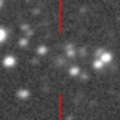
|
Now it is 14.6 mag (Aug. 5, J. L. Virlichie, P. Traverse, H. Roy, G. Houdin). Fading slowly. It will be unobservable in January.
Date(TT) R.A. (2000) Decl. Delta r Elong. m1 Best Time(A, h)
Oct. 7 18 30.77 -34 17.1 2.884 2.942 83 15.5 19:00 ( 20, 18)
Oct. 14 18 39.93 -34 27.6 2.981 2.950 78 15.6 18:51 ( 21, 17)
|

|
It approached to Earth down to 0.29 a.u. in early February, and it brightened up to 4.5 mag (Feb. 1, Juan Jose Gonzalez). Now it is 14.8 mag (Sept. 15, Thomas Lehmann). Fading slowly. In the Northern Hemisphere, it will be unobservable soon. In the Southern Hemisphere, it stays observable in good condition.
Date(TT) R.A. (2000) Decl. Delta r Elong. m1 Best Time(A, h)
Oct. 7 6 29.95 -50 39.7 3.648 3.764 88 15.6 4:35 (351, 4)
Oct. 14 6 23.25 -53 1.4 3.684 3.838 91 15.7 4:40 (358, 2)
|

|
David Rankin detected its cometary activity in June. Now it is 15.7 mag (Sept. 24, Ken-ichi Kadota). It stays 16 mag for a while. It stays observable in good condition.
Date(TT) R.A. (2000) Decl. Delta r Elong. m1 Best Time(A, h)
Oct. 7 22 5.03 -4 15.3 1.386 2.233 138 15.7 21:02 ( 0, 51)
Oct. 14 22 5.97 -4 16.8 1.422 2.214 131 15.6 20:36 ( 0, 51)
|
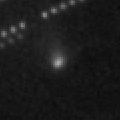
|
It brightened very rapidly. Now it is 15.2 mag (Aug. 23, ATLAS South Africa). It will fade out rapidly after this. It will be fainter than 18 mag in December. In the Northern Hemisphere, it is not observable now, but it will appear in November. In the Southern Hemisphere, it will be unobservable soon.
Date(TT) R.A. (2000) Decl. Delta r Elong. m1 Best Time(A, h)
Oct. 7 14 18.08 -18 8.3 2.927 2.070 25 15.6 19:00 ( 73, -7)
Oct. 14 14 22.57 -16 51.2 3.004 2.085 18 15.8 18:51 ( 76, -9)
|

|
It is expected to brighten up to 14.5 mag in winter. Now it is 16.7 mag (Sept. 27, Thomas Lehmann). It stays 15 mag for a while. It stays observable in good condition.
Date(TT) R.A. (2000) Decl. Delta r Elong. m1 Best Time(A, h)
Oct. 7 3 32.04 15 16.9 1.800 2.634 138 15.8 2:32 ( 0, 70)
Oct. 14 3 30.37 15 30.4 1.713 2.599 145 15.6 2:03 ( 0, 71)
|

|
It is expected to brighten up to 14 mag in 2024 summer. At the high light, it is not observable in the Northern Hemisphere. Now it is 16.6 mag (Sept. 26, Catalina Sky Survey). It stays 16 mag for a while. In the Northern Hemisphere, it will be getting lower gradually. In the Southern Hemisphere, it stays observable in good condition.
Date(TT) R.A. (2000) Decl. Delta r Elong. m1 Best Time(A, h)
Oct. 7 3 16.61 -9 59.6 3.147 3.966 140 16.0 2:17 ( 0, 45)
Oct. 14 3 10.52 -12 23.1 3.062 3.919 144 15.9 1:43 ( 0, 43)
|

|
Now it is 14.8 mag (Sept. 16, Taras Prystavski). Fading slowly. It stays observable in good condition.
Date(TT) R.A. (2000) Decl. Delta r Elong. m1 Best Time(A, h)
Oct. 7 0 20.77 -8 15.5 2.719 3.693 164 16.0 23:17 ( 0, 47)
Oct. 14 0 16.43 -8 28.3 2.764 3.709 158 16.0 22:45 ( 0, 47)
|
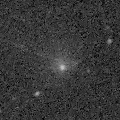
|
Very large comet. It is expected to brighten up to 13 mag in 2031. Now it is 15.8 mag (Sept. 11, Taras Prystavski). It stays 16 mag for a while. In the Northern Hemisphere, it is not observable now. In the Southern Hemisphere, it stays observable in good condition. In the Northern Hemisphere, it is not observable until 2030.
Date(TT) R.A. (2000) Decl. Delta r Elong. m1 Best Time(A, h)
Oct. 7 3 28.36 -64 43.4 16.881 17.153 104 16.2 2:28 ( 0,-10)
Oct. 14 3 26.12 -65 3.5 16.874 17.128 103 16.1 1:58 ( 0,-10)
|
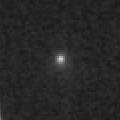
|
It is expected to brighten up to 15 mag from autumn to winter. Now it is 17.4 mag (Sept. 16, ATLAS Chile). It stays 16 mag for a while. In the Northern Hemisphere, it is not observable now, but it will be observable soon. In the Southern Hemisphere, it stays observable in good condition.
Date(TT) R.A. (2000) Decl. Delta r Elong. m1 Best Time(A, h)
Oct. 7 2 7.20 -58 16.5 1.283 1.927 114 16.5 1:08 ( 0, -3)
Oct. 14 1 48.97 -56 56.2 1.255 1.903 114 16.2 0:23 ( 0, -2)
|
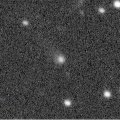
|
Now it is 16.5 mag (Apr. 10, Michael Jager). It stays 16 mag for a while. In the Northern Hemisphere, it will be unobservable in November. In the Southern Hemisphere, it stays observable in good condition.
Date(TT) R.A. (2000) Decl. Delta r Elong. m1 Best Time(A, h)
Oct. 7 9 33.46 -36 22.4 4.196 3.704 54 16.3 4:35 (316, 0)
Oct. 14 9 36.52 -38 49.1 4.142 3.706 57 16.3 4:40 (322, 2)
|
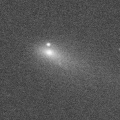
|
It brightened up to 12.8 mag in spring (Mar. 8, Taras Prystavski). Now it is 16.1 mag (Sept. 13, Ken-ichi Kadota). It will fade out rapidly after this. It will be fainter than 18 mag in November. It stays observable in good condition.
Date(TT) R.A. (2000) Decl. Delta r Elong. m1 Best Time(A, h)
Oct. 7 0 59.17 -5 42.9 1.687 2.675 168 16.3 0:00 ( 0, 49)
Oct. 14 0 52.34 -5 58.9 1.736 2.712 165 16.5 23:21 ( 0, 49)
|
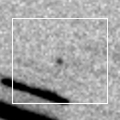
|
It is expected to brighten up to 8.5 mag from January to February. Now it is 19.1 mag (Sept. 26, P. Carson). Brightening rapidly. It stays observable in good condition.
Date(TT) R.A. (2000) Decl. Delta r Elong. m1 Best Time(A, h)
Oct. 7 3 0.76 21 22.6 0.955 1.859 144 16.9 2:01 ( 0, 76)
Oct. 14 3 2.31 21 21.4 0.876 1.813 150 16.4 1:35 ( 0, 76)
|
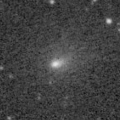
|
Now it is 16.7 mag (Sept. 5, Thomas Lehmann). Fading rapidly. It will be fainter than 18 mag in November. It locates somewhat low in the Northern Hemisphere. In the Southern Hemisphere, it will be getting lower gradually.
Date(TT) R.A. (2000) Decl. Delta r Elong. m1 Best Time(A, h)
Oct. 7 18 52.81 -28 9.6 1.801 2.037 88 16.4 19:00 ( 17, 25)
Oct. 14 18 56.52 -30 30.3 1.992 2.105 82 16.7 18:51 ( 19, 22)
|

|
Now it is 16.2 mag (Sept. 13, ATLAS South Africa). Fading slowly. It will be fainter than 18 mag in December. It locates somewhat low in the Northern Hemisphere. In the Southern Hemisphere, it will be getting lower gradually after this, and it will be unobservable in December.
Date(TT) R.A. (2000) Decl. Delta r Elong. m1 Best Time(A, h)
Oct. 7 17 50.59 -21 53.1 3.081 2.977 74 16.6 19:00 ( 34, 25)
Oct. 14 17 59.28 -22 0.2 3.212 3.016 69 16.7 18:51 ( 36, 24)
|
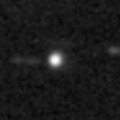
|
Now it is 16.6 mag (Sept. 18, Ken-ichi Kadota). Fading slowly. It will be fainter than 18 mag in January. In the Northern Hemisphere, it stays observable in good condition. In the Southern Hemisphere, it will be getting lower gradually. It was very faint as 21.5 mag in 2021. It seems to be bright temporarily in outburst.
Date(TT) R.A. (2000) Decl. Delta r Elong. m1 Best Time(A, h)
Oct. 7 21 6.41 -12 0.7 3.965 4.576 122 16.6 20:04 ( 0, 43)
Oct. 14 21 6.62 -12 0.4 4.074 4.591 115 16.7 19:37 ( 0, 43)
|

|
Very far object. Now it is 16.7 mag (Sept. 15, J. L. Virlichie, P. Traverse, H. Roy). It stays 17 mag for a while. In the Northern Hemisphere, it is not observable now. In the Southern Hemisphere, it stays observable in good condition.
Date(TT) R.A. (2000) Decl. Delta r Elong. m1 Best Time(A, h)
Oct. 7 5 26.22 -75 13.6 10.265 10.315 90 16.8 4:24 ( 0,-20)
Oct. 14 5 16.75 -75 50.3 10.280 10.314 89 16.8 3:47 ( 0,-21)
|

|
The cometary activity was detected by Masayoshi Yoshimi on Sept. 15. Now it is 16.0 mag (Sept. 15, Masayoshi Yoshimi). It will fade out rapidly after this. It will be fainter than 18 mag in November. In the Northern Hemisphere, it stays observable in good condition. In the Southern Hemisphere, it will be unobservable soon.
Date(TT) R.A. (2000) Decl. Delta r Elong. m1 Best Time(A, h)
Oct. 7 21 17.71 37 41.9 0.228 1.138 122 16.8 20:15 (180, 87)
Oct. 14 21 18.58 45 21.1 0.243 1.129 117 17.0 19:48 (180, 79)
|
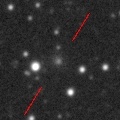
|
Now it is 17.0 mag (Sept. 16, Jean-Claude Merlin). It stays 17 mag for a while. It will be getting lower gradually after this, and it will be unobservable in January in the Northern Hemisphere, or in December in the Southern Hemisphere.
Date(TT) R.A. (2000) Decl. Delta r Elong. m1 Best Time(A, h)
Oct. 7 18 19.90 -12 22.3 2.440 2.505 81 16.8 19:00 ( 32, 37)
Oct. 14 18 29.07 -12 30.1 2.509 2.490 77 16.8 18:51 ( 34, 36)
|
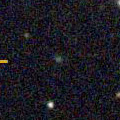
|
Now it is 17.2 mag (Sept. 26, ATLAS-HKO, Haleakala). It stays 17 mag for a while. In the Northern Hemisphere, it stays observable in good condition. It stays extremely low in the Southern Hemisphere.
Date(TT) R.A. (2000) Decl. Delta r Elong. m1 Best Time(A, h)
Oct. 7 5 2.27 39 59.3 6.252 6.714 113 16.9 4:03 (180, 85)
Oct. 14 5 2.38 40 20.1 6.156 6.710 119 16.8 3:35 (180, 85)
|

|
Now it is 16.6 mag (Sept. 27, ATLAS Chile). It stays 17 mag for a while. It stays observable in good condition.
Date(TT) R.A. (2000) Decl. Delta r Elong. m1 Best Time(A, h)
Oct. 7 4 59.21 -11 28.7 6.955 7.439 115 16.9 3:59 ( 0, 44)
Oct. 14 4 58.76 -11 46.9 6.846 7.407 120 16.9 3:31 ( 0, 43)
|

|
It brightened up to 14.1 mag in 2022 spring (Mar. 22, 2022, Chris Wyatt). It was expected to brighten up to 13 mag. But actually, it was fainter than originally expected. Now it is 16.1 mag (Sept. 26, ATLAS Chile). Fading slowly. It will be fainter than 18 mag in January. It stays observable in good condition.
Date(TT) R.A. (2000) Decl. Delta r Elong. m1 Best Time(A, h)
Oct. 7 2 24.67 -2 39.8 4.439 5.360 154 16.9 1:25 ( 0, 52)
Oct. 14 2 17.47 -2 38.5 4.454 5.407 161 17.0 0:51 ( 0, 52)
|
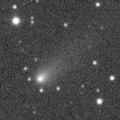
|
Now it is 16.3 mag (Sept. 22, ATLAS South Africa). Fading slowly. It will be fainter than 18 mag in November. In the Northern Hemisphere, it will never be observable after this. It locates somewhat low in the Southern Hemisphere.
Date(TT) R.A. (2000) Decl. Delta r Elong. m1 Best Time(A, h)
Oct. 7 15 57.23 -40 25.5 3.084 2.640 54 17.0 19:00 ( 42, -4)
Oct. 14 16 12.43 -40 50.5 3.165 2.660 51 17.1 18:51 ( 42, -5)
|
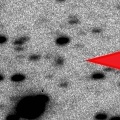
|
Now it is 17.7 mag (Sept. 14, Jean-Claude Merlin). It stays 17 mag for a while. In the Northern Hemisphere, it is not observable now, but it will appear in January. In the Southern Hemisphere, it will be getting lower gradually after this, and it will be unobservable in November. But it will be observable again in December. It stays 16 mag in the Southern sky for a long time from 2024 to 2025.
Date(TT) R.A. (2000) Decl. Delta r Elong. m1 Best Time(A, h)
Oct. 7 16 23.31 -39 32.3 6.771 6.318 59 17.2 19:00 ( 39, 0)
Oct. 14 16 23.92 -39 32.0 6.841 6.289 52 17.2 18:51 ( 41, -2)
|

|
Now it is 17.6 mag (Sept. 26, ATLAS-HKO, Haleakala). It stays 17 mag for a while. In the Northern Hemisphere, it stays observable in good condition. It stays extremely low in the Southern Hemisphere.
Date(TT) R.A. (2000) Decl. Delta r Elong. m1 Best Time(A, h)
Oct. 7 5 9.76 39 4.1 4.884 5.344 112 17.4 4:10 (180, 86)
Oct. 14 5 10.16 38 58.3 4.768 5.321 118 17.3 3:43 (180, 86)
|
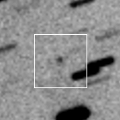
|
Now it is 17.5 mag (Sept. 28, Ken-ichi Kadota). It stays 17 mag for a while. In the Northern Hemisphere, it stays observable in good condition. In the Southern Hemisphere, it is not observable now, but it will appear in November.
Date(TT) R.A. (2000) Decl. Delta r Elong. m1 Best Time(A, h)
Oct. 7 0 58.62 58 27.5 3.767 4.438 126 17.4 23:54 (180, 66)
Oct. 14 0 36.59 58 6.4 3.720 4.419 129 17.3 23:04 (180, 67)
|

|
It brightened up to 13.4 mag in last summer (July 7, 2022, Giuseppe Pappa). Now it is 17.4 mag (Sept. 7, Thomas Lehmann). It stays 18 mag for a while. It locates somewhat low in the Northern Hemisphere. But it will become high in winter. In the Southern Hemisphere, it will never be observable after this.
Date(TT) R.A. (2000) Decl. Delta r Elong. m1 Best Time(A, h)
Oct. 7 15 29.29 29 19.9 5.264 4.712 51 17.4 19:00 (105, 33)
Oct. 14 15 32.56 29 11.6 5.342 4.760 49 17.4 18:51 (106, 30)
|

|
Now it is 17.0 mag (Sept. 28, A. Diepvens). Fading slowly. It will be fainter than 18 mag in December. It stays observable in good condition.
Date(TT) R.A. (2000) Decl. Delta r Elong. m1 Best Time(A, h)
Oct. 7 3 58.75 6 48.7 2.302 3.069 132 17.4 2:59 ( 0, 62)
Oct. 14 3 57.25 6 19.7 2.253 3.080 139 17.4 2:30 ( 0, 61)
|
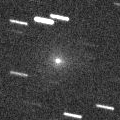
|
It was expected to brighten up to 11 mag in July. But actually, it was fainter than originally expected. Now it is 18.5 mag (Sept. 25, W. Hasubick). Fading rapidly. It will be fainter than 18 mag soon. It will be getting higher gradually.
Date(TT) R.A. (2000) Decl. Delta r Elong. m1 Best Time(A, h)
Oct. 7 9 53.54 1 55.0 2.053 1.507 44 17.5 4:35 (284, 22)
Oct. 14 10 7.66 0 12.7 2.073 1.574 47 18.0 4:40 (288, 24)
|
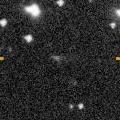
|
First return of a new periodic comet which brightened up to 15 mag in 2008. Now it is 18.8 mag (Sept. 23, A. Diepvens). It will fade out rapidly after this. It will be fainter than 18 mag in November. It stays observable in good condition.
Date(TT) R.A. (2000) Decl. Delta r Elong. m1 Best Time(A, h)
Oct. 7 4 9.25 15 13.2 1.915 2.667 129 17.6 3:10 ( 0, 70)
Oct. 14 4 8.32 13 49.9 1.880 2.696 136 17.7 2:41 ( 0, 69)
|

|
It brightened up to 14 mag from 2020 to 2021. Now it is 17.9 mag (Aug. 24, W. Hasubick). It stays 18 mag for a while. It stays observable in good condition.
Date(TT) R.A. (2000) Decl. Delta r Elong. m1 Best Time(A, h)
Oct. 7 3 1.50 3 30.8 3.885 4.753 146 17.9 2:02 ( 0, 59)
Oct. 14 2 57.96 3 14.5 3.849 4.764 153 17.9 1:31 ( 0, 58)
|

|
Now it is 17.5 mag (Sept. 7, P.-J. Dekelver). Fading slowly. It will be fainter than 18 mag soon. It locates somewhat low in the Northern Hemisphere. It stays extremely low in the Southern Hemisphere.
Date(TT) R.A. (2000) Decl. Delta r Elong. m1 Best Time(A, h)
Oct. 7 15 55.92 20 59.2 3.464 2.970 52 17.9 19:00 ( 92, 35)
Oct. 14 16 8.12 19 14.0 3.517 2.986 50 18.0 18:51 ( 91, 33)
|

|
Now it is 17.6 mag (Sept. 27, ATLAS Chile). It stays 18 mag for a while. It stays extremely low in the Northern Hemisphere. In the Southern Hemisphere, it stays observable in good condition.
Date(TT) R.A. (2000) Decl. Delta r Elong. m1 Best Time(A, h)
Oct. 7 5 16.30 -38 0.5 7.682 7.992 104 18.0 4:16 ( 0, 17)
Oct. 14 5 16.25 -38 36.1 7.614 7.966 107 17.9 3:48 ( 0, 16)
|

|
It returned for the first time in 68 years. It will brighten up to 7.5 mag in 2024 summer. Now it is 19.8 mag (Sept. 27, J. Nicolas, F. Kugel). It will brighten rapidly after this. It stays observable in good condition. At the high light, it locates low in the Northern Hemisphere, or it is not observable in the Southern Hemisphere.
Date(TT) R.A. (2000) Decl. Delta r Elong. m1 Best Time(A, h)
Oct. 7 4 26.36 -18 44.7 2.969 3.591 121 19.1 3:26 ( 0, 36)
Oct. 14 4 23.81 -19 26.3 2.843 3.522 125 18.8 2:56 ( 0, 36)
|
|
![]()
 C/2022 E2 ( ATLAS )
C/2022 E2 ( ATLAS ) 126P/IRAS
126P/IRAS 62P/Tsuchinshan 1
62P/Tsuchinshan 1 C/2019 T4 ( ATLAS )
C/2019 T4 ( ATLAS ) C/2022 L2 ( ATLAS )
C/2022 L2 ( ATLAS ) C/2021 G2 ( ATLAS )
C/2021 G2 ( ATLAS ) C/2021 Y1 ( ATLAS )
C/2021 Y1 ( ATLAS ) 213P/Van Ness
213P/Van Ness C/2023 A3 ( Tsuchinshan-ATLAS )
C/2023 A3 ( Tsuchinshan-ATLAS ) 237P/LINEAR
237P/LINEAR 199P/Shoemaker 4
199P/Shoemaker 4 C/2022 E3 ( ZTF )
C/2022 E3 ( ZTF ) 471P/2023 KF3
471P/2023 KF3 C/2023 K1 ( ATLAS )
C/2023 K1 ( ATLAS ) 32P/Comas Sola
32P/Comas Sola C/2022 S4 ( Lemmon )
C/2022 S4 ( Lemmon ) 117P/Helin-Roman-Alu 1
117P/Helin-Roman-Alu 1 C/2014 UN271 ( Bernardinelli-Bernstein )
C/2014 UN271 ( Bernardinelli-Bernstein ) 226P/Pigott-LINEAR-Kowalski
226P/Pigott-LINEAR-Kowalski C/2022 A3 ( Lemmon-ATLAS )
C/2022 A3 ( Lemmon-ATLAS ) 71P/Clark
71P/Clark 144P/Kushida
144P/Kushida C/2022 W3 ( Leonard )
C/2022 W3 ( Leonard ) 81P/Wild 2
81P/Wild 2 P/2023 M4 ( ATLAS )
P/2023 M4 ( ATLAS ) C/2019 E3 ( ATLAS )
C/2019 E3 ( ATLAS ) 2019 AV4
2019 AV4 219P/LINEAR
219P/LINEAR C/2021 S4 ( Tsuchinshan )
C/2021 S4 ( Tsuchinshan ) C/2022 QE78 ( ATLAS )
C/2022 QE78 ( ATLAS ) C/2020 Y2 ( ATLAS )
C/2020 Y2 ( ATLAS ) 77P/Longmore
77P/Longmore C/2023 F3 ( ATLAS )
C/2023 F3 ( ATLAS ) C/2022 U3 ( Bok )
C/2022 U3 ( Bok ) C/2022 U1 ( Leonard )
C/2022 U1 ( Leonard ) C/2020 R7 ( ATLAS )
C/2020 R7 ( ATLAS ) 170P/Christensen
170P/Christensen 185P/Petriew
185P/Petriew 465P/2023 L1 ( Hill )
465P/2023 L1 ( Hill ) 246P/NEAT
246P/NEAT C/2022 U4 ( Bok )
C/2022 U4 ( Bok ) C/2022 R6 ( PanSTARRS )
C/2022 R6 ( PanSTARRS ) 13P/Olbers
13P/Olbers![]()























































